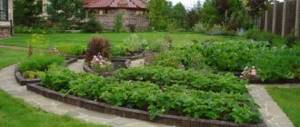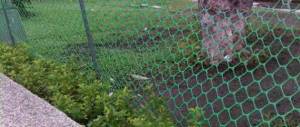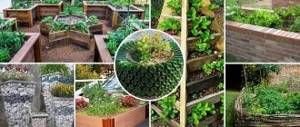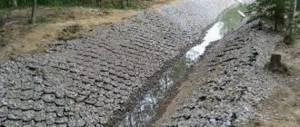The sizes of land plots vary. Residents of rural areas are the most fortunate in this matter - up to 20 acres are often allocated for plantings alone. But the closer to the city, the less free land there is. Dacha plots are sometimes of the most modest size. It would seem that you can grow on an area of 6 acres, including buildings? How to plan a vegetable garden on a small plot in order to get at least a small harvest?
With the right approach, in a limited space you can plant not only parsley and dill, but even potatoes, tomatoes and garden berries. When planning to set up a vegetable garden, you should initially pay attention to the following factors that directly affect the future harvest:
- location of the site and beds;
- soil quality;
- presence of shaded areas.
Site location
Plots of land with a completely flat surface are a rare occurrence. Much more often, many of them have their own disadvantages, which must be taken into account when setting up a vegetable garden. So, if they are in a low-lying area, this can lead to increased soil moisture. In this case, you will need to build drainage outlets, as well as add soil to the beds from time to time.
If the site is located on a slope, the beds should be made not along it, but across it.
Areas in elevated areas are exposed to winds, so to create a barrier to drafts, they need to be planted with tall plantings (trees, shrubs) around the perimeter.
What do they fill the ridge with?
All the autumn leftovers that are often thrown away can be placed in a box on top of a rough base. The thickness of the layer will be 30 cm; if necessary, deepen the pit to fill the rough part. The remaining layers will take no more than 30 cm.
Location on. The illustration for the article is used under the standard license ©ofazende.ru
Backfilling is carried out in several stages:
- coarse large residues in a layer of any thickness;
- tops, foliage, etc. – 5 cm;
- removed turf, straw cutting, etc. (5-15 cm);
- leaf residues mixed with fertile soil, if it was taken out from under the bed (a layer of any thickness that the side allows).
Related article:
Features of the fight against dandelions in the garden: how to remove the weed
It is advantageous to make lazy beds high, then they can be used longer. A filled structure resembles a compost heap, in which there is a not too thick covering layer (remnants of tops, soil, etc.).
Some tips for planning your vegetable garden
To make smart use of a small space, you can use the following “tricky” techniques:
- select low-growing plants for planting;
- use early ripening varieties and plant them in two passes;
- combine crops with different ripening periods in one bed (for example, sow lettuce over potatoes);
- plant climbing crops in hanging pots or near an arch or fence.
Types of beds for a small vegetable garden
To make optimal use of a small area, you can do the following:
- Make vertical beds. They will take up little space, but this will not affect the yield. Strawberries feel great in plastic pipes, and an improvised hut is suitable for cucumbers.
- Arrange containers . Portable beds are convenient to use on any terrain, even if it is not level.
- Build raised beds. To do this, each bed should be raised above the soil level, and the edges should be fenced off so that the soil does not spread. This option is suitable for lowland areas.
- Grow vegetables in bags. The method of planting potatoes in a bag has proven itself well. And hanging pocket bags allow you to use the space twice - you can install containers under them.
How to rationally plan a site - video
Planning a garden to properly arrange it and obtain the required amount of harvest will help solve many problems. Inexperienced summer residents and gardeners, having planted their own convenient garden, complain that there is not the required abundance of fruits and vegetables that they were counting on.
3D layout option for a plot of 15 acres with the location of a garden, house and vegetable garden
How to plan a garden and dacha plot
Site planning is considered the most important stage in its arrangement. The planning of a summer cottage and garden plot directly begins with a preliminary study of the soil where garden and vegetable crops are to be grown, and the climatic conditions that affect the number of fruits. If the soil is excessively clayey or contains sand impurities, then you need to additionally add peat to it, feed it with black soil, other substances and fertilizers, on which the proper nutrition of the roots will directly depend.
In the climate, the fundamental factors that negatively affect the fruiting process are:
- excess humidity;
- frosty winters;
- spring frosts.
Therefore, it is important to select trees and crops that are most suitable for a particular region.
Sketch and layout of a vegetable garden, garden and the entire plot of 10 acres
Important aspects are the layout of the garden and the proper selection of trees. Locally selected trees are considered the most frost-resistant. They adapt perfectly to any climatic conditions and give good results, if not annually, then every other year. The hardiest trees are cherries, pears, apples, and plums. Apricots and peaches are considered the least resistant to frost and high humidity.
Cherry does not tolerate closely located groundwater at all, and if reclamation is not carried out in time, then in just a few years it will dry out.
Planning for the arrangement of a small suburban area
There are a variety of options for planning a summer cottage and garden, therefore, when selecting the required assortment of trees and plants, it is necessary to take into account their future productivity.
An example of planning a vegetable garden on a small plot
To decide how many trees need to be planted on a garden plot, you must first mark out the dacha plot, taking into account the existing buildings. This must be done because every object casts a shadow, so when planting bushes, trees and other crops in the shade of buildings, they will not bear fruit, but will be drawn into the area of natural light. This will continue until the top of the plants is slightly higher than the barrier that limits access to natural light.
Tips for dividing the site
As already mentioned, it is not at all necessary to allocate the entire available area for a vegetable garden. If you do not plan to sell vegetables and do not want to spend the entire summer solely caring for plants, select a small piece of land on the southern edge of the site. Before planting a vegetable garden, check whether the area is obscured by neighboring buildings or trees. If everything is good, you can start forming the beds. When dividing an area into beds, adhere to four fundamental rules to provide the plants with the most favorable conditions:
The most favorable hours for lighting plants are morning and evening. During the day, the sun burns too much and does more harm than good to your plantings. Therefore, when developing a site, first of all, note whether the rays of the cosmic luminary will hit the plants from dawn and whether they will have enough evening warmth.
Small vegetables are planted in beds that are oriented north to south. Neighboring crops do not interfere or shade each other, so this arrangement helps to get a good harvest. If most of the garden is occupied by tall plantings, it is better to place them from east to west. This way the sun will evenly pass through all the rows, and each sprout will receive enough “attention”.
In areas with a slope, you cannot make vertical ridges: there will be too much moisture at the bottom, and, on the contrary, at the top it will be very dry. In such situations, it is better to strengthen the earthen strips and paths between them with the help of boards and add more soil. And arrange the plants depending on their preferences - moisture-loving ones under the hill, and those that prefer drier soil at the very top.
Regardless of your seeding plans, it's best to make your beds the same size. A width of 45 centimeters is considered today the most convenient for processing. Choose the length at your discretion. It is recommended to use sizes from 3 to 9 meters - it all depends on what crops and in what quantity you plan to plant.
How to combine a garden and a vegetable garden
Planning a vegetable garden is considered a fairly important stage, because it is imperative to correctly distribute the usable area. The program for designing and planning a site begins with the idea of directly arranging the beds, which must be ideal. If you need a layout for your vegetable garden and garden, then you need to make two separate diagrams that will display your dacha plot at different times of the year. Thus, it is possible to achieve a more competent distribution of free space. When making calculations, you need to take into account not only the area of the dacha plot itself, but also take into account the fact that the planted crops can grow over time.
Drawing and layout of a plot of 6 acres with a combination of garden and vegetable garden
In addition, it is worth remembering that planting vegetable and garden crops should not be done too densely. You need to think about where the vegetable garden will be located on the dacha plot being developed. Experienced gardeners recommend planting all crops on the south side, however, if this is not possible, then it is worth selecting sunny areas, but with some periods of shade.
It is imperative to take into account the rules for planting each plant, its compatibility with neighboring crops, the need for natural sunlight and fertilizer, and the frequency of watering.
The planning of the garden plot is carried out taking into account the fruiting periods of all existing trees and shrubs. It is best to place all crops in the garden and vegetable garden taking into account the periods of their full ripening. The scheme for planting all crops at the dacha must certainly be planned very competently. In order to think through everything correctly, you need to prepare a photo of your dacha with the adjacent land.
Initially, you need to draw the location of the house on the diagram, and if the site has not yet been fully developed, then you need to indicate its estimated location and size. It is necessary to indicate not only the size of the vegetable garden and garden itself, but also their distance from the boundaries of a certain area. When thinking through the design of your dacha, you can diversify the area with flowers. This will give it a beautiful decorative look and help you look at your garden in a completely new way.
What is a lazy bed?
It is best to build it in the fall after harvesting. Divide the garden in advance into sections for boxes, select durable sheet material for fencing (remnants of roofing materials, metal profiles, other non-rotting sheets at least 50 cm wide).
High beds. The illustration for the article is used under the standard license ©ofazende.ru
Suitable for filling the beds:
- remnants from the uprooting of a new territory;
- hard large stems (corn, sunflower, Jerusalem artichoke, etc.);
- potato tops, zucchini and pumpkin lashes.
You can also use branches after pruning the old garden, and other wood waste.
The main requirement for the lower tier of fillers is rotting within 2-4 years. This part will supply heat.
To prevent rodents from infesting the ridge, the bottom is covered with a fine mesh. You can make a shallow pit under the box or place the structure directly on top of the main soil. The height of the side is at least 50 cm, the distance between the ridges is 50-70 cm, depending on the convenience of the owner.
What models can there be for planning a garden?
There may be a variety of options for planning a garden, but with each of them you must take into account:
- number of designated acres;
- soil characteristics of the garden and vegetable garden;
- required number of arranged beds.
Layout and placement of beds in a vegetable garden measuring 4 acres
Decorative design of a summer cottage is ideal for those who prefer to arrange a rather unpretentious garden and vegetable garden, which implies the use of mainly ornamental crops and green spaces. Often this model is in the shape of a circle. It should contain exquisite beautiful flowers and other plants to fully show off their beauty.
Outside, a certain design is created, consisting of green spaces. It is best if these are low shrubs so that the beauty of the planted flowers can be fully demonstrated. If the size of the dacha plot is quite impressive, then fruit trees are planted behind in a semicircle, the number of which directly depends on the area of the proposed model. A rather interesting option is the rectangular shape.
Drawing and site layout
The peculiarity of this model implies that in this case you need to plan the garden and vegetable garden together. Often, the design of such a summer cottage involves the use of a square shape. The peculiarity of such a plot is that it is possible to plant as many vegetable beds as the size of the plot allows.
You can place a few berry bushes next to garden crops. For the best view of your summer cottage, it is worth planting additional fruit trees, but placing them a little away from all other crops. The peculiarity of this layout is that despite the abundance of species, the original form remains.
Sketch and layout of plantings on a plot of 5 acres
An interesting and unusual option is the free layout of the existing land. The shape and size of such a plot depend directly on the available acres. When developing such a scheme, you need to consider whether it is possible to combine several different crops with fruit trees.
If the area of land for a vegetable garden remains quite small, then it is best to use the method of arranging vertical beds. Tall vegetables and legumes will thrive on nets and various supports. When organizing a vegetable garden, it is necessary to take into account the compatibility of crops and the need for well-arranged natural lighting. In addition, it is worth considering that to design a garden plot, you do not need to plant old trees. In this case, young seedlings are quite suitable.
ABC of gardening » Waste into income, or How to increase soil fertility without fertilizers
Waste into income, or How to increase soil fertility without fertilizers
I want to share one of the most useful ways to increase soil fertility in the garden, which I have been using since 2003 and still haven’t given up. And this suggests that the method is correct and, indeed, brings results. Soil quality improves
, it is infested with earthworms
,
which has a positive effect on the health of plants, which look better and bear fruit.
I’ll call this method “waste into income.” First, about the advantages of this method:
1. No material investments 2. Minimal labor costs 3. You only need a shovel and a bucket And now let's move on directly to
work
. We choose a bush or tree that needs to increase soil nutrition. Actually, any pet in the garden needs this. We retreat from the trunk of a bush or tree so as not to damage the root system and so that the branches do not interfere. For example, in an adult apple tree I step back from the trunk by about a meter. And we dig a hole as wide and deep as the bayonet of a shovel:
As you can see, here I stepped back from the trunk of the bush about twenty centimeters. My model in this case is a honeysuckle bush (honeysuckle goes into hibernation early, which is why the bush looks so unsightly). For the display, I prepared half a bucket of carrion. Pour the carrion into the hole:
And right in the hole we chop with a shovel:
We make three or four such holes around the trunk of a bush or tree:
We put the dug soil next to it.
We fill the holes gradually. As soon as kitchen waste appears, I throw it there. As soon as she collected bad fruits or weeded the beds, she threw the plant remains into the pits. Slops are also poured into pits. As soon as the holes are filled, they must be filled with the excavated soil. A mound may be forming. Not scary! As it rots and during the winter, the plant waste will freeze and settle. And by spring the earth will be level. You can make such holes or trenches anywhere in the garden
.
And not only around already planted bushes or trees. This can be done at the intended location for planting a tree or shrub. But, of course, this must be done in advance so that the plant waste has time to rot and turn into compost. You don't have to worry about your lawn. There is a smooth lawn around my mature apple trees. And no one realizes that sometimes I feed the apple trees this way. I carefully remove the turf, take out the soil onto the oilcloth, do everything described above, sprinkle it with earth, and put the removed turf back. And I scatter the excess soil, if there is any, in the garden or use it for another purpose. For example, for indoor flowers. I start preparing such pits at any time of the year, as long as the soil allows it. That is, from early spring to late autumn
. But I most often do this in the summer and early autumn, because it’s not very pleasant to stomp around in boots on squishy soil and freeze. And also because at this time there is especially a lot of plant waste: carrion, tops from garden crops. All this can become excellent compost right under the tree.
In this way you can
prepare trench beds.
But it is better to prepare them
in late summer or autumn
for the future planting season.
To do this, I dig a trench as deep as a spade bayonet. I know a summer resident who digs with two bayonets. In my opinion, this is unnecessary work. But, apparently, it’s more convenient for him. The width of the trench depends on how wide the bed I want to make. Length, respectively, too. I put the dug soil (there won’t be much of it) nearby. I put kitchen waste, plant debris, mowed grass, and weeded weeds (which have not yet been fertilized) into the trench. If I want to make the garden bed warmer, I add hay, sawdust, and fallen leaves. It is a kind of biofuel
.
Of course, I put all of the above in place not at once, but over a period of time. It happens that it takes a month to “stuff” the beds. In the same way, I chop with a shovel and mix the contents of the trench during the “stuffing” process, pour out the slop or spill with water, if necessary. As soon as the trench bed is filled with plant debris and other things, I lay the same dug soil on top. That is, the principle is the same as for the pit. The bed will appear higher, but over the winter, of course, the inside contents will fall off. Such beds will be warmer than ordinary beds
because they are quickly warmed up by the sun and decaying plant “garbage”.
It is best to sow cucumbers, zucchini, zucchini, squash, and pumpkins
.
If the top layer of soil is at least 15 centimeters, then I also sow dill, lettuce, and radishes. It is better to sow other crops (especially carrots, garlic, beets) in this bed after one season, or better yet after two. Not all crops like rotting plant “garbage”. The frequency is as follows:
* in the 1st year I sow cucumbers, zucchini, zucchini, squash or pumpkin, * in the 2nd year - peas, beans or other legumes, cabbage (I don’t “stuff” the trench beds with anything anymore) * in the 3rd year 1st year - the rest of the crops (naturally, I don’t fill the trench beds with anything) By the way, the “waste to income” method is perfect for those who do
not have the opportunity
or do not want
to prepare compost heaps or pits
.
You don’t have to look for a special place for a compost heap in your summer cottage or garden. And you can easily dispose of all plant waste by preparing trench beds or planting holes. In addition, there is no need to waste time transferring compost from a compost heap or pit to beds or under fruit trees and shrubs. The compost there, one might say, is already “laying down” itself, as evidenced by the earthworms
. Actually, that's all! In this simple way you can turn waste into income by increasing soil fertility without chemical fertilizers and without unnecessary physical labor. In such fertile soil, almost anything will grow.
What do you do with plant residues?
Tell us about it. Always with you, Katerina Shlykova Quoting and partial copying
of articles and stories is possible with the source indicated in the form of
an active link
to the corresponding page of the site.
You might also be interested in:
| How to grow crocuses... |
| Daffodils - how to court... |
| How to care for geranium... |
| Category: ABC's of gardening | Date: 08/25/2016 | Author: Katya Shlykova | |
| Views: 5700 Tags: Fertile soil, biofuel, BIO, plant waste, compost, filling beds, soil fertility, fertilizers, carrion, garden soil Rating: 4.4 / 7 |
| Total comments: 0 | |
Leave a comment:
Antispam is working! Please, no advertising or links to third-party resources. About this via Feedback.











